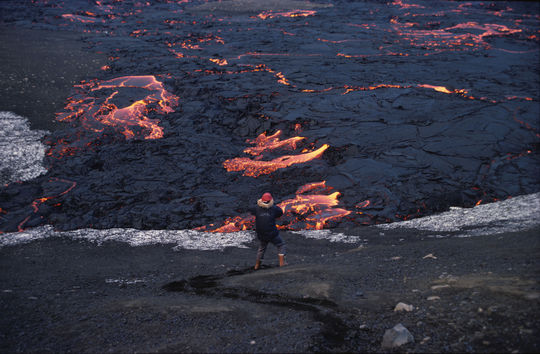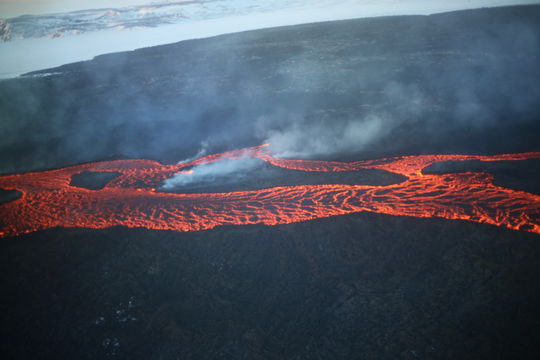Lava flow
Lava flows
Holuhraun 2014; lava from the eruption. Photo: Oddur Sigurðsson.
A lava flow is a stream of magma flowing from the eruption vent, over the surface around the vent. Lava flows can be of various types, it depends on the chemical composition on the magma, the temperature and the rout where the magma is transported through the crust. The landscape also has some effects on how the lava flows. Magma usually erupts as lava flows or lava fountains. The speed of the magma depends on various factors:
- Type of the magma and its viscosity
- The steepness of the slope surface.
- If the magma flows as one big spread or in a narrow channel or a magma tunnel.
- The rate of the magma coming from the vent
Basaltic magma can flow tens of kilometers from the eruption vent and the margin of the lava can go up to 10 km/hour depending on slope. Usually the transport time is shorter, but if the slope gradient is high, or the magma is flowing through a narrow channel or tunnels, the speed can reach over 30 km/hour. Magma with higher silica content is more viscous than the basaltic magma and does not flow as fast, it goes only a few meters per hour. An example of this magma would be Dacite or Rhyolite.
Lava flow is usually not a fatal event since lava most often does not flow faster than a person can run. The hazard related to lava flow is more commonly on infrastructure, that is, damage or destruction of buildings or other structures i.e. power line and roads. Lava flows can also close off escape routes. Lava flows can threaten water sources due to pollution from the magma, it can also slow down the infiltration into aquifers.
An example of damages from lava flows is the eruption in Heimaey in 1973. Heimaey is in the Vestmannaeyjar Archipelago west of Iceland and it lies within an active volcanic zone. During the eruption of 1973 a part of the town was submerged by the lava and the sailing routes to the harbour was almost closed off because of the lava flow. A world known operation to cool the advancing lava with sea water saved the harbor.
| Largest flood basalts in Iceland during historical time | ||||||
| Name | Year | Type | Thickness (m) | Length (km) | Area (km2) | Volume (km3) |
| Frambruni | 900 | Pahoehoe lava | 15 | 33 | 250 | 4 |
| Eldgjárhraun | 934-940 | Pahoehoe lava | 23 | 72 | 792 | 18 |
| Hallmundarhraun | 950 | Pahoehoe lava | 33 | 55 | 255 | 8 |
| Skaftáreldahraun | 1783-1784 | Pahoehoe lava | 25 | 65 | 599 | 14 |

Gjástykki; Krafla eruption 1980. Photo: Oddur Sigurðsson.




